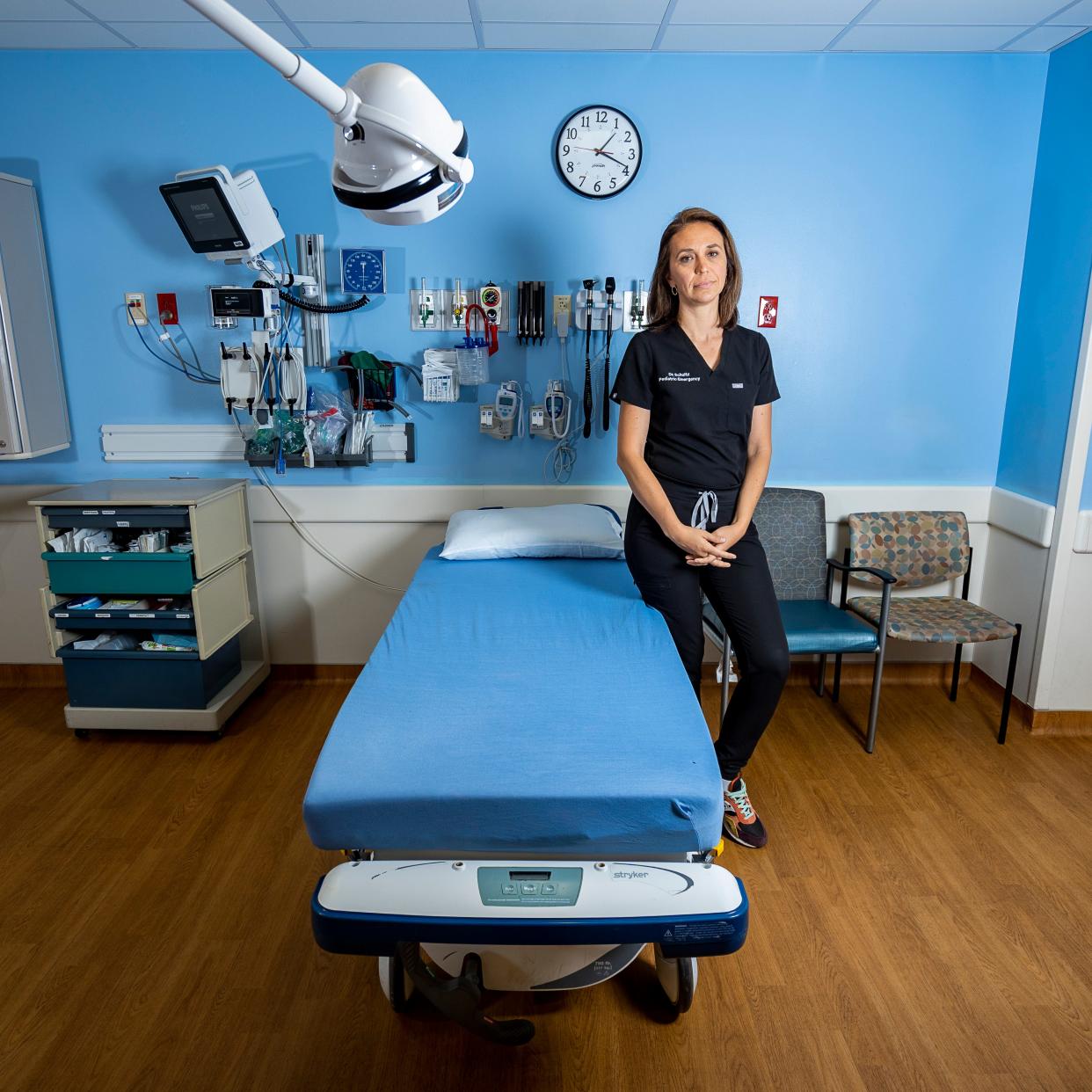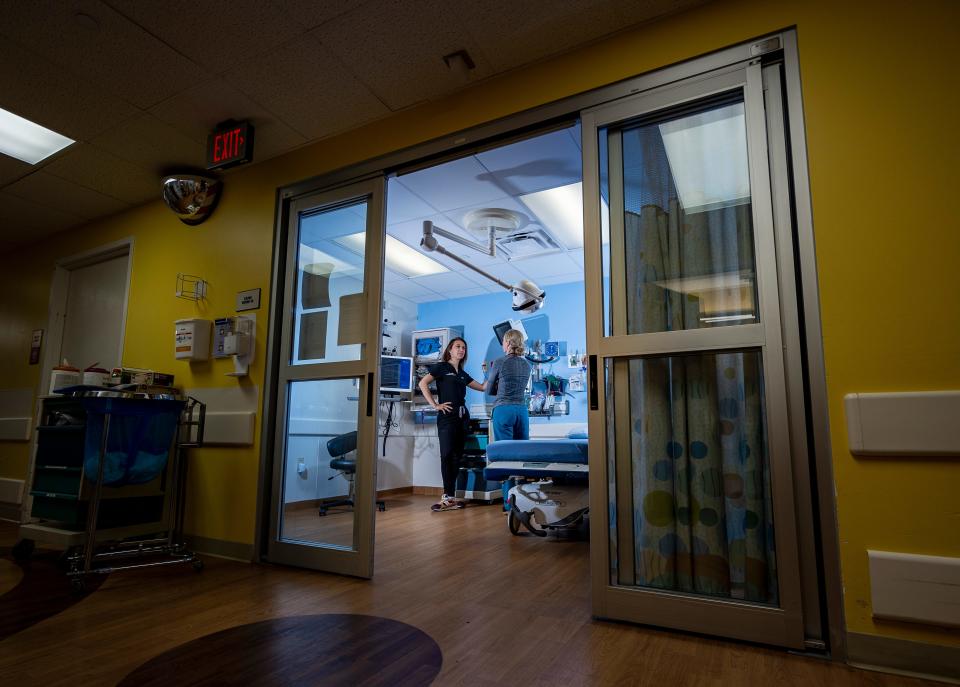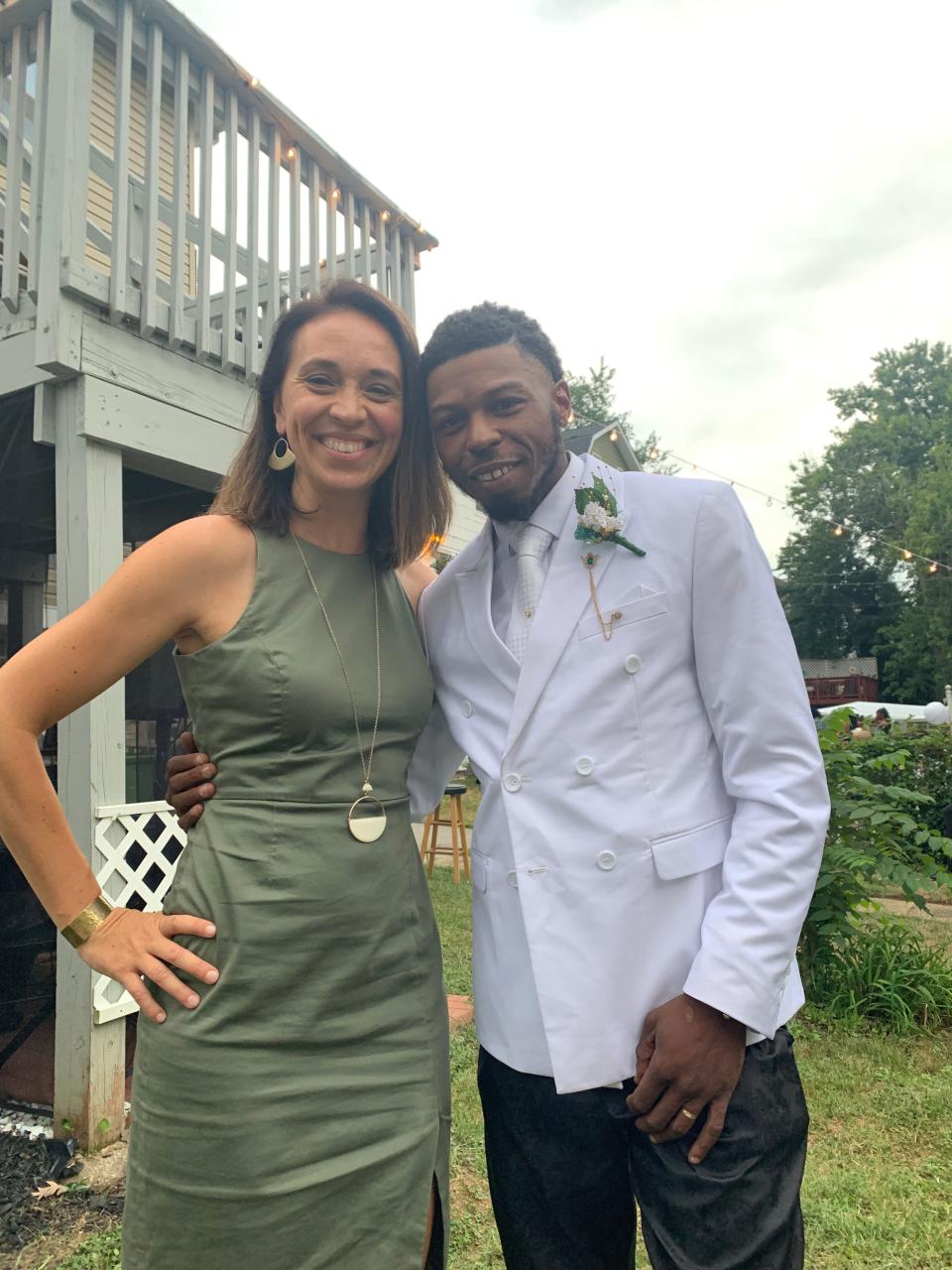This Milwaukee doctor sees kids shot every week. She wants the gun violence to stop.

- Oops!Something went wrong.Please try again later.
Dr. Megan Schultz, a pediatric emergency physician, started her career at a Boston hospital.
In three years, she treated two children for gunshot wounds.
Then, she took a job at Children's Wisconsin in Milwaukee.
She treated three kids who had been shot — in her first week.
Dozens and dozens more patients have followed since then.
Schultz, 41, knows how to save a life. What she wants more, though, is for her patients to have not been shot in the first place.
“It is morally and emotionally exhausting to see children shot by guns as often as we do,” she said.
She is one of many physicians across the country drawing attention to laws and political decisions they believe put their patients at risk. For some, the topic is abortion or gender-affirming care. For Schultz, it's guns.
In an op-ed published this summer in the Milwaukee Journal Sentinel, Schultz and Dr. Ryan Scheper, another pediatric emergency physician, called on the state Legislature to enact stronger gun legislation, citing decades of research. More than 140 of their Children’s Wisconsin colleagues signed the letter.
“When I talk about this with my colleagues, we are stunned that more people are not crying about this all the time,” Schultz said in an interview.
“Guns are the number one killer of children,” she continued. “I don't know why that's not front-page news every day.”
This is the story of one doctor, in one city, and how she came to believe she had no choice but to speak out.
How teaching at a Baltimore school led to a career in medicine
It wasn’t Boston or Milwaukee that shaped Schultz most.
It was Baltimore.
She went to the city as a member of Teach For America. The program sends college graduates to work as teachers in low-income schools across the country.
She was shocked at what she saw at Frederick Douglass High School. Students could not drink from water fountains because of the old lead service lines supplying them. There were no uniforms for the track team. There were no reliable buses.
For Schultz, who had grown up in Crandon and attended high school in Cedarburg, it was jarring.
"It really just seemed forgotten," she said.
Torreantoe Smalls remembers Schultz, who taught ninth grade Spanish, as a young, “cool” teacher who gave students like him a safe place to learn and be themselves.
Smalls was a popular drum major at the school known for its music program. But he was struggling with Spanish. One afternoon, he went to after-school tutoring for help before an exam. He made Schultz promise not to tell anyone he had dropped by.
She kept the secret. Smalls did well on the test.
A couple of years later, Smalls was 18 and graduating. He had a choice of schools to attend on a music scholarship. He also was considering enlisting in the Marines.
And then, on Aug. 29, 2004, someone shot him.
One shooting, 41 surgeries and 19 months of recovery
Smalls just needed change for the bus.
He had performed at two church services that morning and went to a friend’s house to watch preseason football. He took a different route home so he could stop at a gas station for the change he needed the next day.
A group of men across the street called out to him, asking if he wanted to buy some weed. He declined.
As he left the gas station, he noticed the men had crossed the street. One demanded to know what he had in his pocket and reached for him. There was a tussle. Smalls broke free and ran.
He heard a gunshot behind him.
The next thing he remembers is waking up in the hospital.
He had been wounded in the stomach, injuring his intestines and pancreas. One of his lungs collapsed. He had a breathing tube inserted and could not talk. He rapidly lost weight.
He spent 19 months in hospitals and care facilities, undergoing more than 40 surgeries.
Schultz was still teaching at Smalls’ high school. She came to visit him in those early weeks when he still had a breathing tube.
“I didn’t know how bad I really was, but you could see the reaction in her face,” Smalls said. “She was trying to hold back tears. Even though she didn’t let them fall, a lot of tears formed.”
At the time, Schultz had recently completed a master’s degree in education. Seeing the devastation felt by her former student and his family changed her career path.
“Maybe I should be a doctor instead,” she thought. “Maybe this is how I want to help kids.”
The decision took her from Baltimore to Madison for medical school, then to Boston for a residency in pediatrics and finally to Milwaukee for a fellowship in emergency medicine.
She joined the faculty of the Medical College of Wisconsin in 2018 and has been here ever since.
Milwaukee has seen a rise in shootings with young victims
A pager announces an incoming trauma patient to the Children’s emergency room.
Sometimes, the injury is from a car crash or fall. More often, it’s from a gunshot.
Two pediatric physicians and a trauma surgery team are ready. The physicians will take the lead in examining the patient, making treatment decisions and coordinating care. An anesthesiologist is posted at the top of the bed. A half dozen nurses draw labs and hook up monitors. At least one pharmacist is on hand to mix and dispense medication.
Radiology technicians are at the bedside for any needed X-rays. A child life specialist will talk to the patient and their family, trying to relieve stress and anxiety as best they can. Two staff from the intensive care unit are ready to take over once the immediate crisis is over.
From the start of the year to the end of July, this scene had unfolded 101 times for a firearm injury.
It’s an extraordinary rise compared to the same time in earlier years when Children's emergency staff treated 79, 64 and 38 patients wounded in 2022, 2021 and 2020, respectively. This year, five of those patients died from their injuries.

“Once there’s a bullet involved, it just does absolutely whatever it wants to do and it doesn’t play fair,” said Emily Bilot, who has been a nurse at Children’s for a decade.
“These kids come in talking and all of sudden they’re not,” she said.
Bilot met Schultz five years ago when she started working in the emergency department and the two grew closer through serving on an advocacy committee at the hospital. Children's Wisconsin has several advocacy committees and legislative priorities, including healthcare access, supporting public health and preventing childhood injuries.
Bilot and Schultz have had patients who were shot swinging on a playground, sitting at a kitchen table, buckled in the backseat of a car and scootering in an alley behind their home.
“I think, especially in our city, such an easy way to end the conversation is to say that it’s kids who are doing the wrong thing who are getting hurt,” said Bilot, who signed on to Schultz’s op-ed earlier this year.
“But the work that we do shows that’s not true,” she said. “It’s kids from all over the city.”
The painful task of bearing witness to violence
When a person dies from a gunshot wound, it’s not quick.
They seize. They scream. They lose control of their bodily functions.
It is traumatizing to witness.
“I hate that paramedics have to see that. I hate that other kids and families have to see that. I hate that the police have to see that. I hate that me and my colleagues have to see that,” Schultz said.
In her first op-ed published last year, Schultz described what it's like to witness a mother lose a child, writing:
She screamed and screamed as I announced that her son was dead. The screams of a mother after her child dies are not of this world. They are guttural, they are ghostly, and they will haunt you for the rest of your days.
Two people in her life have helped her understand the toll of witnessing such violence.
The first was her brother, an airborne medic who deployed twice to Afghanistan. He, more so than Schultz's fellow pediatricians, has experience with what Schultz and her colleagues see regularly.
Take an open thoracotomy, a last-ditch attempt to save a trauma patient with a gunshot injury who loses a pulse. In the span of 60 seconds, a surgeon will slice open a patient’s chest and use their hand to massage the heart to try to get it beating again.
Most pediatric doctors never witness one. Schultz has seen the procedure about a dozen times since she first came to Children’s in 2015.
The second person who understands what emergency room staff experiences regularly is Warren McDuffie Sr., a retired Milwaukee police officer who serves as a public safety officer at the hospital.
“I told her the same thing I told myself: You can’t get emotionally involved,” McDuffie said. “Stay focused on what it is you can control in that room.”
What sets Schultz apart, he said, is her ability to connect with patients and their families. Sometimes, she takes an extra few minutes to explain something or answer a question. Other times, she cracks a joke, her laughter joining with her patients.
"You can see her passion in conversations and the way she performs her job," McDuffie said. "I have a great deal of respect for her. She’s doing this because she really genuinely cares."
Why this physician remains optimistic for the future
Schultz often thinks of her former student in Baltimore.
They lost touch for a period of years after his initial recovery from the shooting.
Smalls, now 37, said he was working fast-food jobs and struggled to land permanent housing after the shooting. Eventually, he turned back to music and booked regular gigs.
His band project blossomed into an entertainment company, where he rents out equipment and studio time. He began managing other artists.
When he got married in 2022, he wanted to invite people who had made an impact on him. He sent invitations to two former teachers: his band director and Schultz.

“Ms. Schultz, she’s a heartfelt person,” he said. “She knows there’s something that she can give and be of use. And her jumping into this advocacy has given me a deeper passion to want to be a voice, too.”
Schultz said the policies she and her colleagues have called for are evidence-based. Most have broad support among Wisconsin voters.
The proposals include background checks on all gun sales, restricting domestic abusers from owning guns, allowing family members and law enforcement to temporarily remove guns from unsafe individuals in crisis, and prohibiting assault-style weapons and high-capacity magazines.
Some people wrote to her after her editorials to say if earlier mass shootings did not change policy, nothing else would.
To Schultz, that is like her telling a cancer patient that the first round of chemotherapy did not work so they should stop all treatment.
“It's fatalistic and pointless,” she said.
“I will never give up while kids are dying of a very preventable disease.”
THANK YOU: Subscribers' support makes this work possible. Help us share the knowledge by buying a gift subscription.
DOWNLOAD THE APP: Get the latest news, sports and more

Need more help with crime and safety questions? The Milwaukee Resource Guide is here to help. Have something you want answered? Submit a question.
This article originally appeared on Milwaukee Journal Sentinel: This Milwaukee doctor sees kids shot every week. She wants it to stop.

